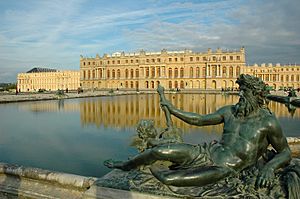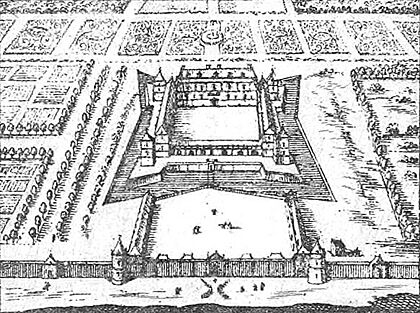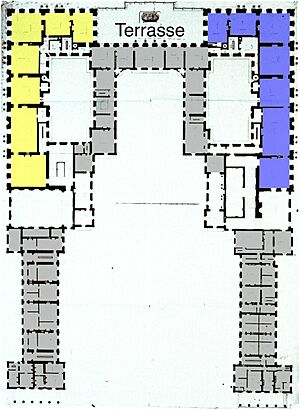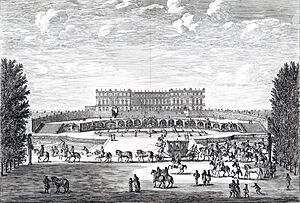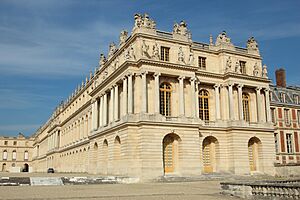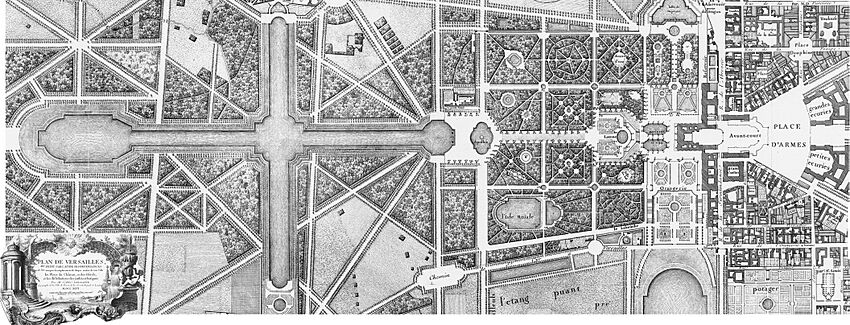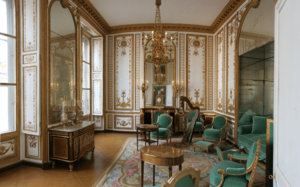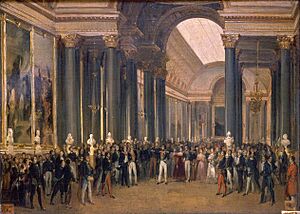History of the Palace of Versailles facts for kids
The Palace of Versailles is a huge royal palace in Versailles, Yvelines, France. It's like a giant castle! When it was first built, Versailles was just a small country village. Today, it's a busy suburb of Paris, about 20 kilometers (12 miles) southwest of the capital city.
The Palace of Versailles was the main place of power in France from 1682. This was when King Louis XIV moved his royal court from Paris to Versailles. The royal family stayed there until October 1789, when the French Revolution began and they had to return to Paris. Because of this, Versailles is famous not just as a beautiful building, but also as a symbol of the powerful kings who ruled France before the Revolution.
Contents
How Versailles Began
The name "Versailles" first appeared in a document from before 1038. It mentioned a local lord named Hugo de Versailliis.
Back then, Versailles was a small village with a little castle and a church. Its location on the road from Paris to Normandy helped it grow. However, after the Plague and the Hundred Years' War, the village was mostly destroyed, and its population dropped a lot. In 1575, a man named Albert de Gondi, who was important in the court of King Henry II, bought the land of Versailles.
King Louis XIII's Hunting Lodge
In the early 1600s, Gondi invited King Louis XIII to hunt in the forests around Versailles many times. Louis XIII loved the spot so much that he ordered a hunting lodge to be built there in 1624. This small castle was made of stone and red brick with a blue roof.
Eight years later, King Louis XIII bought the land of Versailles from the Gondi family. He then started to make the hunting lodge bigger. A map from 1652 shows the lodge with a main building, two side wings, and towers at the corners. It was surrounded by a moat. There was also a garden with a fountain and neat flowerbeds.
Louis XIV, who would become the next king, played and hunted at this very spot when he was a boy. With some changes, this hunting lodge would become the heart of the huge new palace.
King Louis XIV's Grand Vision
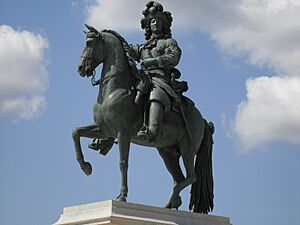
King Louis XIII's son, Louis XIV, was very interested in Versailles. He decided to turn his father's hunting lodge into one of the biggest palaces in the world! Starting in 1661, a team of talented artists and builders began to work on the palace. These included the architect Louis Le Vau, the garden designer André Le Nôtre, and the painter Charles Le Brun.
Louis XIV wanted to create a new center for his royal court. After some peace treaties in 1678, he slowly started to move his court to Versailles. The court officially moved there on May 6, 1682.
By moving his court and government to Versailles, Louis XIV wanted to have more control over the powerful noble families. He also wanted to be further away from the people of Paris. All the power of France came from Versailles. Government offices were there, along with homes for thousands of nobles, their helpers, and all the people who worked for the court.
Louis XIV made it a rule that nobles of a certain rank had to spend time at Versailles each year. This stopped them from gaining too much power in their own regions and kept them from challenging his rule. He created very strict court rules and ceremonies. For example, his morning routine, called the Lever, was a detailed ceremony where many nobles watched him get up. These French court manners were soon copied in other royal courts across Europe.
The expansion of the palace became a symbol of Louis XIV's absolute power. In 1661, after his chief minister died, Louis declared that he would be his own chief minister. He wanted all his advisors and regional rulers to be close to him. He feared they might rebel, so he believed keeping them nearby would make them powerless. Louis XIV hired the same talented people who had worked on another grand château, Vaux-le-Vicomte, to build Versailles. There were four main building periods for Versailles, often linked to Louis XIV's wars.
First Building Period
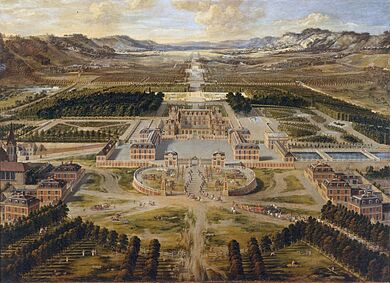
The first building period (1664–1668) began with a huge party called The Pleasures of the Enchanted Island in May 1664. This party was meant to celebrate the two queens of France, but it also honored the king's mistress. The celebration was seen as a warm-up for a war Louis would fight against Spain. During this period, the château and gardens were changed to fit the 600 guests invited to the party.
Second Building Period
The second building period (1669–1672) started after a peace treaty ended a war. During this time, the palace began to look more like it does today. The most important change was adding a new section, called the enveloppe, around Louis XIII's hunting lodge. This new part, sometimes called the château neuf (new castle), surrounded the old lodge on three sides.
At first, Louis XIV thought about tearing down his father's palace completely. But then he decided to keep it. So, the plans for the new section had to be changed, and the new rooms were made a bit smaller.
The new building provided new living spaces for the King and his family. The main floor of the new castle was entirely for two large apartments: one for the King and one for the Queen. The King's apartment was on the north side, and the Queen's was on the south.

The western part of the new section was mostly a terrace. This terrace was later enclosed to create the famous Hall of Mirrors. The ground floor of the north side had the "bath apartment" with a special sunken tub for hot and cold water. The King's brother and sister-in-law lived on the ground floor of the south side. The top floor had private rooms for the king and rooms for his children.
It was very unusual for the King's and Queen's apartments to have the same layout and size. Some believe this was done because Louis XIV wanted his wife, Maria Theresa, to also be queen of Spain, creating a "dual monarchy." The decoration of these rooms showed the "heroic actions of the king" through stories from ancient history.
Third Building Period
After another peace treaty in 1678, the third building period at Versailles began (1678–1684). The court had grown, and Louis XIV wanted to make sure he had enough space for all the nobles. His own family had also grown, including his five children with his mistress, who now needed proper apartments.
Under the lead architect, Jules Hardouin-Mansart, the Palace of Versailles got much of its current look during the 1680s. The artist Le Brun worked on the interior decorations and helped with the garden design. As a sign of France's new power in Europe, Louis XIV officially moved his court to Versailles in May 1682.
Hardouin-Mansart designed two huge new wings to solve the space problems. The South Wing, also called the Aile des Princes (Princes' Wing), was built first in 1679. It was very long and had three inner courtyards for servants and nobles. The princes had luxurious apartments facing the gardens. In 1684, work began on the North Wing, which housed other important nobles. These two new wings created 175 new places to live. Both wings looked similar to the earlier new section, making the garden side of the palace look grand and balanced.
Many other important buildings were also constructed during this third phase. These included the Grand Commun (a large building for the King's household), the Orangerie (a greenhouse for orange trees), the Grand Trianon (a smaller palace), and two large stables called the Petite and Grand Ecurie. The Orangerie was built into a hillside and had a long, arched gallery.
The two stables were very impressive. They were built opposite the main palace, on either side of the main road leading to Versailles from Paris. Hardouin-Mansart designed them to be grand buildings, not just simple stables. They could hold thousands of horses and nearly 1,500 people who worked for the Royal Stables. The "Grand" Stable housed the King's hunting horses and hounds, while the "Petit" Stable held the King's carriages.
During this period, parts of the King's and Queen's Grand Apartments were changed. Louis XIV stopped living in his Grand Apartment. Instead, these rooms were used for official state events and ceremonies. The new Hall of Mirrors and the grand staircase created a huge path for parties and celebrations. The King's old bedroom became a throne room. The rooms were decorated with amazing objects made of solid silver, showing off the best French craftsmanship.
For his new private apartment, Louis XIV chose rooms in the older part of the palace that had belonged to his father. To make a grand entrance, three large waiting rooms were created before his bedroom. The Queen continued to live in her Grand Apartment, with some changes. One room became a dining room for the Grand Couvert, a daily meal where the King and Queen ate in front of the court.
Fourth Building Period
After a difficult war (1688–1697), Louis XIV began his last building period at Versailles (1699–1710). This period focused almost entirely on building the royal chapel. In 1701, more changes were made to the King's apartment, including the creation of the Salon de l'Œil de Bœuf and the King's new bedroom. This new bedroom was placed right in the center of the palace's west side. After the chapel was finished in 1710, almost all building work at Versailles stopped for many years.
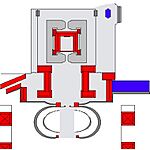 |
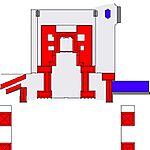 |
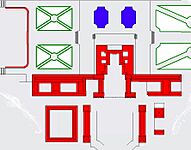 |
| The palace in 1668 | The palace in 1674 | The palace in 1680 |
King Louis XV's Changes
After Louis XIV died in 1715, his five-year-old great-grandson, King Louis XV, and the court moved back to Paris. In 1717, the Russian Tsar Peter the Great visited Versailles. He studied the palace and gardens, using them as inspiration for his own palace, Peterhof, in Russia.
When Louis XV and the court returned to Versailles in 1722, the first project was to finish the Salon d'Hercule, which had been started by Louis XIV.
Louis XV added several important parts to Versailles. These included his own small private apartments and apartments for his daughters and the heir to the throne. The biggest achievements during his reign were building the Opera House and the Petit Trianon, a smaller, more private palace.
However, Louis XV also had the grand Escalier des Ambassadeurs (Ambassadors' Staircase) removed. This was the only grand entrance to the State Apartments. He did this to make room for apartments for his daughters.
The gardens mostly stayed the same as they were under Louis XIV. The most important change Louis XV made to the gardens was finishing the Bassin de Neptune (Neptune Fountain) between 1738 and 1741.
Towards the end of his reign, Louis XV started to redesign the courtyards of the palace. He wanted to give the entrance a more classical look. This project continued under King Louis XVI but wasn't finished until the 20th century.
King Louis XVI's Reign
In 1774, soon after he became king, Louis XVI ordered many of the old trees in the gardens to be replanted because they had died. Only a few changes were made to the original garden design. Some areas were changed, like the Bains d'Apollon, which was redone in a popular English-Chinese style. The Labyrinth garden was also changed into a smaller Queen's Garden.
The French monarchy's money problems led to the palace not being kept up very well. One visitor, Benjamin Franklin, said it had an air of "magnificence and negligence." Royal architects warned that some buildings, like the stables, were in dangerous condition.
To make things worse, Louis XVI spent a lot of money on other properties, like buying and renovating the Chateau de Saint-Cloud and rebuilding the Château de Compiègne. This left little money for the "Grand Project" at Versailles. This project aimed to rebuild the Paris-facing wings of the palace to match the newer parts. In 1780, Louis XVI finished one wing, but the project was stopped when France faced a huge debt crisis in 1787, followed by the start of the French Revolution.
Inside the palace, the library and game rooms in the King's and Queen's private apartments were redecorated for Marie Antoinette. These rooms are beautiful examples of the Louis XVI style. Several new floors were added above the King's private apartment, making it six stories high. Louis XVI liked to walk on the roof and enjoy the views. These extra floors were meant to be temporary and were later removed in the 1800s to bring back the palace's original look.
The French Revolution and After
On October 6, 1789, the royal family was forced to leave Versailles and move to the Tuileries Palace in Paris. This happened after the Women's March on Versailles. During the early years of the French Revolution, the people of Versailles largely helped protect the palace.
In October 1790, Louis XVI ordered the palace furniture to be moved to Paris. But the mayor and council of Versailles wrote to the King, saying that removing the furniture would ruin the city's economy. Louis XVI was touched and canceled the order.
However, eight months later, the future of Versailles was decided. After Louis XVI was arrested in 1791, the government declared that all royal family possessions were abandoned. To protect the palace, it was sealed off. In 1792, it was suggested that the palace's furniture be sold and the palace itself either sold or rented. The furniture was sold at auctions between 1793 and 1795. Only special art pieces were saved to be part of a new museum.
In 1793, it was even suggested that the metal statues in the gardens of Versailles be melted down to make cannons! This idea was discussed but not carried out. In 1794, the government decided that the palace and gardens of Versailles would not be sold. Instead, they would be cared for by the Republic for the public good. Because of this, the palace became a storage place for artworks taken from churches and noble homes. These collections later became part of the planned museum.
A collection of interesting natural objects from America was also found at Versailles. This collection was bought by a prince and later taken by the state. A man named Fayolle, who was in charge of this collection, became the first director of the new museum at Versailles in 1794. Another official, André Dumont, was shocked by how run-down the palace and gardens had become. He quickly took charge and put together a team to look after the museum's collections.
One of Dumont's first hires was Huges Lagarde, a wealthy merchant. With the palace abandoned, there were over 100 libraries with more than 200,000 books and manuscripts. Lagarde became a driving force behind Versailles becoming a museum. He brought in other experts, including a painter to be the curator for paintings.
However, due to political changes in France during the 1790s, Versailles suffered more damage. Mirrors were used to pay off government debts, and fabrics from curtains and furniture were taken to get the gold and silver from them. Even though it was a museum, parts of Versailles were used to house wounded soldiers.
In 1797, the museum was reorganized and renamed. The grand apartments were used as galleries to display famous artworks. The museum, including the garden sculptures, became a wonderful museum of classic French art.
Under Napoleon's Rule
When Napoleon came to power and created the First French Empire, the status of Versailles changed again. Paintings and artworks from the museum were moved to other places, and the museum eventually closed. In 1804, Versailles was named an imperial palace.
Napoleon himself did not live in the palace, but apartments were prepared for his wife, Empress Marie Louise. The Emperor preferred to stay at the Grand Trianon. The palace continued to house wounded soldiers. However, in 1805, Pope Pius VII visited the palace and blessed the crowds from the balcony of the Hall of Mirrors.
The Bourbon Kings Return
When the Bourbon kings returned to power, not much happened at Versailles. Some parts of the gardens were replanted, but no major repairs or changes were made inside the palace. King Louis XVIII often visited the palace and walked through the empty rooms. King Charles X chose to live in Paris and rarely visited Versailles.
The July Monarchy and a New Museum
After the July Revolution of 1830, Louis-Philippe I became king. He also chose to live at the Grand Trianon, but he had a big plan for Versailles.
In 1833, Louis-Philippe decided to create a museum at Versailles dedicated to "all the glories of France." This included even the new royal family and the revolution that brought him to power. For the next ten years, the palace underwent many changes that could not be undone. The museum officially opened on June 10, 1837. It was one of the biggest and most expensive projects of Louis-Philippe's reign.
The southern wing of the palace was turned into the Galerie des Batailles (Hall of Battles). To do this, most of the apartments of the princes who lived there before were torn down. The Hall of Battles was designed to celebrate French military history from ancient times to the early 1800s. Some of the paintings were not very good, but a few were masterpieces. Part of the northern wing became the Salle des Croisades, a room dedicated to famous knights of the Crusades. The apartments of the heir to the throne and his wife, as well as Louis XV's daughters, were turned into portrait galleries. Some of the old wooden wall panels were removed and either stored or sold. During the Prussian occupation in 1871, the stored panels were burned for firewood.
Second Empire and the Third Republic
During the Second Empire, the museum at Versailles mostly stayed the same. The palace was used for important state events, like a visit from Queen Victoria.
Versailles was also the site of very important events during the Franco-Prussian War (1870-1871) and the start of the French Third Republic. During the war, German troops occupied Versailles and made it their headquarters. The Hall of Mirrors and other galleries were used as a hospital for injured German soldiers. It was in the Hall of Mirrors that Wilhelm I was declared German Emperor on January 18, 1871. This was a very bitter moment for the French, as an enemy was crowned in a room that celebrated Louis XIV's victories against the Germans.
When the Paris Commune uprising happened in March 1871, the new French government moved from Paris to Versailles. The members of parliament slept in the Hall of Mirrors and held their meetings in the Royal Opera House. For warmth, they burned wooden panels that were in storage.
After the uprising was put down, the Versailles Opera House remained the seat of the French parliament until 1875. Then, it was decided that the Senate would stay in the Opera, and a new meeting room for the National Assembly would be built. This new room was built in the central courtyard of the South Wing. It opened in 1876 and hosted the National Assembly until they returned to Paris in 1879. The Senate also returned to Paris that same year. Until 1958, every French President was elected in the National Assembly auditorium at Versailles.
Restoring Versailles: Pierre de Nolhac
Pierre de Nolhac became the curator of the Versailles museum in 1892. He wanted to bring back historical galleries that showed the palace as it truly was, unlike Louis-Philippe's museum, which was more about glorifying France. At the same time, Nolhac began to restore the palace to how it looked before the Revolution. To do this, he removed some rooms and artworks and tried to make the rooms look historically accurate.
Nolhac's changes made people see the castle in a new way. Important people, like nobles and the former Empress, came to see the new developments. Nolhac also worked to attract foreign visitors and donors. The owner of a famous newspaper, James Gordon Bennett, Jr., gave money to help restore the 18th-century rooms. The growth of private donations led to the creation of the "Friends of Versailles" group in 1907.
Between the World Wars
Pierre de Nolhac left his position as Curator of Versailles in 1920. His colleague, André Pératé, took over for the next 13 years. By the early 1920s, years of neglect had seriously damaged the palace and gardens. Because France was struggling financially after the war, outside help became more important than ever.
In 1924, an American oil millionaire named John D. Rockefeller was moved by articles describing the poor condition of Versailles. Rockefeller personally wrote to the President of France, offering money to restore the palace. Between 1925 and 1928, the Rockefeller Foundation donated over $2 million (about $30 million in 2014 money) to Versailles. This money helped repair the palace roof, replacing the old slate with more durable lead. Repairs were also made to the stone work and exterior wood. The Orangerie, the Queen's Theater, and other parts of the gardens were also restored.
Rockefeller had a say in how the money was used by setting up a special committee. This committee had to approve the restoration plans. Rockefeller's generosity also encouraged the French government to increase its own funding for Versailles.
The Van der Kemp Period
Under Gérald Van der Kemp, who was the chief conservator of the museum from 1952 to 1980, Versailles saw some of its biggest restoration projects. These included the Opera House (finished in 1957), the Grand Trianon (1965), the Queen's Bedroom (1975), the King's Bedroom, and the Hall of Mirrors (1980). During this time, the ground floor of the northern wing was turned into a gallery of French history from the 1600s to the 1800s. Also, a new rule was made: the French government would try to buy back as much of the original furniture and artwork as possible that had been sold off during the Revolution of 1789.
Versailles Today
With all the past and ongoing restoration work, the French government has strongly promoted Versailles as one of France's top tourist attractions. However, the palace still has political uses. Important world leaders are entertained in the Hall of Mirrors. The French Senate and National Assembly sometimes meet at Versailles to change the French Constitution. This tradition began in 1875. A special organization, the Public Establishment of the Palace, Museum and National Estate of Versailles, was created in 1995 to manage the palace.
In 2008-2009, an exhibition by the artist Jeff Koons was held at Versailles. He said he hoped his modern art would create an exciting mix with the old architecture of Versailles.
The bronze statue of Louis XIV on horseback, which was finished in 1836, was restored in 2009. It was then moved from inside the main courtyard to outside the gates, on the Place d'Armes.


